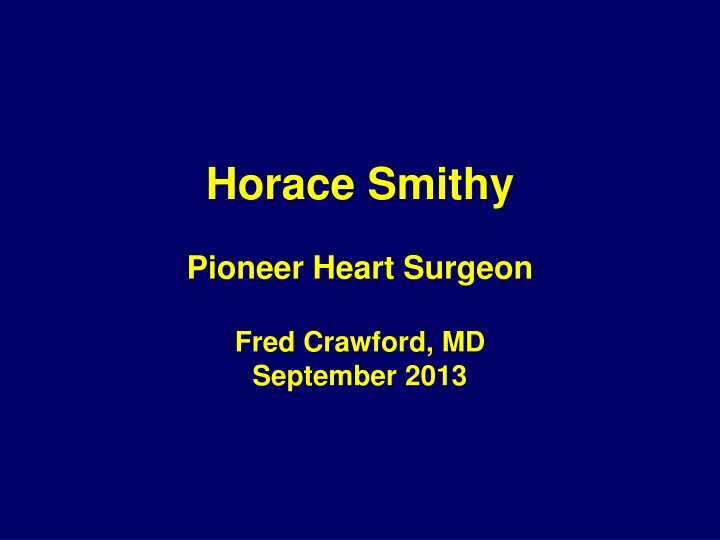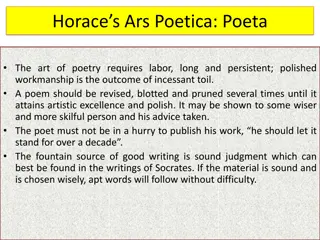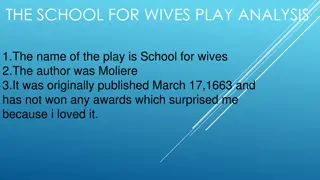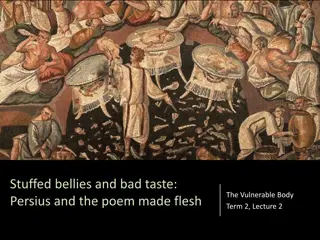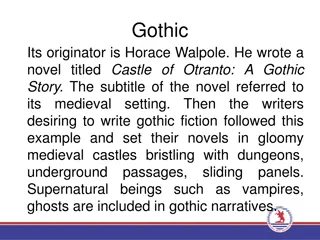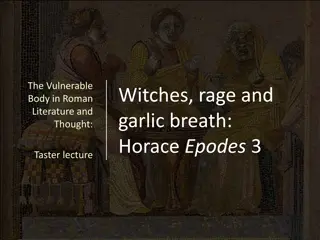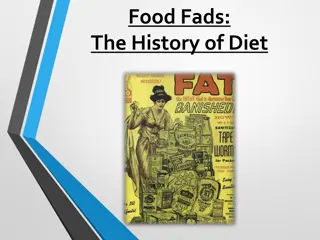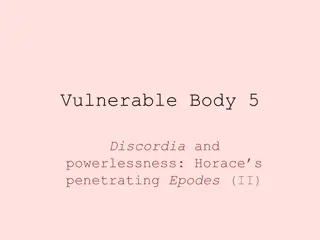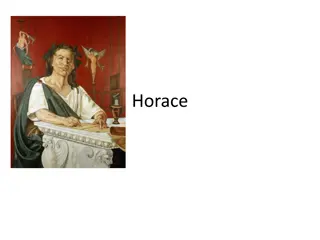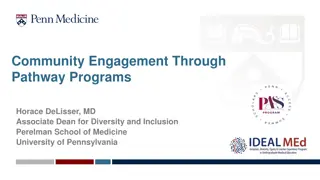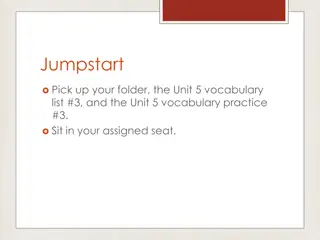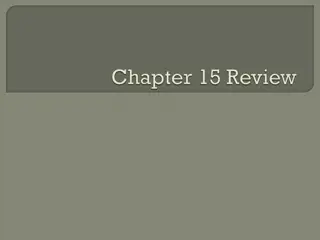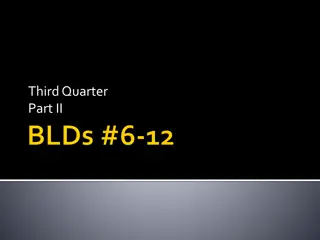Horace Smithy
Horace G. Smithy, born in 1914, made significant contributions in the field of heart surgery, starting from his early education to his groundbreaking procedures. His journey from being a blue baby in Norfolk to a pioneering heart surgeon is documented through images and milestones in his life. His professional career saw notable achievements, such as being appointed as an Assistant Professor of Surgery and conducting research that resulted in 18 published papers. The slides capture key moments, including successful surgeries by other renowned surgeons before him. Explore Horace G. Smithy's life story from his education at prestigious institutions to his impactful medical career.
Download Presentation

Please find below an Image/Link to download the presentation.
The content on the website is provided AS IS for your information and personal use only. It may not be sold, licensed, or shared on other websites without obtaining consent from the author.If you encounter any issues during the download, it is possible that the publisher has removed the file from their server.
You are allowed to download the files provided on this website for personal or commercial use, subject to the condition that they are used lawfully. All files are the property of their respective owners.
The content on the website is provided AS IS for your information and personal use only. It may not be sold, licensed, or shared on other websites without obtaining consent from the author.
E N D
Presentation Transcript
Horace Smithy Pioneer Heart Surgeon Fred Crawford, MD September 2013
May 20, 1923 Elliott Cutler (Boston) successful mitral valvulotomy (knife) on 12 year old girl subsequent patients died of MR procedure abandoned
1925 Sir Henry Souttar (London) mitral valvulotomy (finger) no subsequent referrals
Horace G. Smithy Born blue baby July 19, 1914 Norfolk, Virginia Father originally from Marion, SC Grew up in Washington, DC Considered mother s family estate Rose Hill in Berryville, VA as home
Education Friends School (Washington) 8 years Episcopal High School (Alexandria, VA) 2 years (sinus infections) Miami Military Academy
Undergraduate Education University of Florida (football, baseball, boxing)
Medical Education University of Virginia MD 1938
Family Met Sara Rankin while at University of Florida (born in Columbia, SC; descendent of John C. Calhoun) Married December 23, 1936
Professional Career Appointed Assistant Professor of Surgery MCSC (1942) Worked in dog lab with Edward Parker (Sixth president STSA) Published 18 papers
Dr. Smithy noted that Betty presented with many cardinal signs of chronic heart failure. The veins in her neck stood out chord like; her abdomen was distended by fluid accumulated there because of congestion of the liver; the pressure within her veins was 2 times normal; she was unable to lie down flat, but had to be propped on three pillows in order to breathe with comfort. The Heart of a Surgeon John Kiley, 1984
The operative procedure was without incident and no change occurred in the character of the Auricular fibrillation which was present during the operation Postoperative convalescence was uneventful Orthopnea disappeared entirely. The liver became impalpable Of interest was reversion of the fibrillation by the third postoperative day to normal sinus rhythm. The Heart of a Surgeon John Kiley, 1984
She got on fine with the anesthetic, no trouble at all, and the operation didn t take but an hour and 30 minutes. Interview with Agnes Kleckley, RN, 8/27/2008 Fred A. Crawford, Jr., M.D.
Like many other research men, he is pioneering in a field where he himself is a sufferer.
So far, only Dr. Smithy has tried the operation. Some day, some other surgeon, who will need long laboratory training, might operate on Dr. Smithy himself, whose own heart was damaged in childhood by rheumatic fever. Time, February 16, 1948
Summary 7 4/7 No valve tissue removed 2/4 Died (pneumonia, arrhythmia) in hospital 2/4 Survived no change 3/7 Valve tissue removed 3/3 Survived 6-12 months Patients
Dr. Boones Letter to Dr. Blalock regarding Dr Smithys Condition
Letter from Dr. Blalock to Horace Smithy after John Boones Letter
Horace got a patient to come from South Carolina to Baltimore to undergo the operation. While Alfred Blalock and Dr. Smithy were scrubbing, the patient developed an arrhythmia which degenerated into ventricular tachycardia. This was during induction of anesthesia. Ultimately the patient went into ventricular fibrillation. Dr. Blalock and Smithy opened the patient s chest, but he could not be resuscitated. This discouraged Dr. Blalock greatly. Interview with Dr. William Muller, 10/18/1991 Randolph Chitwood, M.D.
Finally the day arrived for the surgery at Hopkins Anesthesia was started and I made an incision over the fifth intercostal space. Just as I opened the pericardium, the patient developed ventricular fibrillation. Despite all of our efforts to defibrillate and resuscitate, this procedure was not successful. At the time we even used a set of electrodes which I had designed and produced myself for clinical use in the hospital. That was the first defibrillator at the Johns Hopkins Hospital. Horace Smithy was in the operating room at that time, and I looked over at him and saw his face fall. He thought that this was his only chance at having a successful operation for himself. Letter, Denton Cooley September, 2009
New York Times New York Herald Tribune
Have you heard of the article that he was supposed to give in Miami? Well, he sat up in his bed in the oxygen tent that night and dictated that letter to Dr. Stallworth. He knew that he was going to die. He died at 5:30 the next morning after he finished it. Interview with Agnes Kleckley, RN, 8/27/2008 Fred A. Crawford, Jr., M.D.
I left the meeting right after my presentation, as I was worried about Dr. Smithy s survival. Dr. Smithy was very ill but still could talk. He was very anxious to know how everyone responded to his work. (Dr. Smithy) had written part of a paper and wanted me to finish it. After my discussion (with him) regarding the paper, he died the next day. Interview with Dr. Manley Stallworth, 11/11/1991 Randolph Chitwood, M.D.
Pioneer Mitral Valve Surgeons 1/30/1948 Horace Smithy, Jr. 6/10/1948 Charles Bailey 6/16/1948 Dwight Harken 9/1948 Lord Russell Brock
